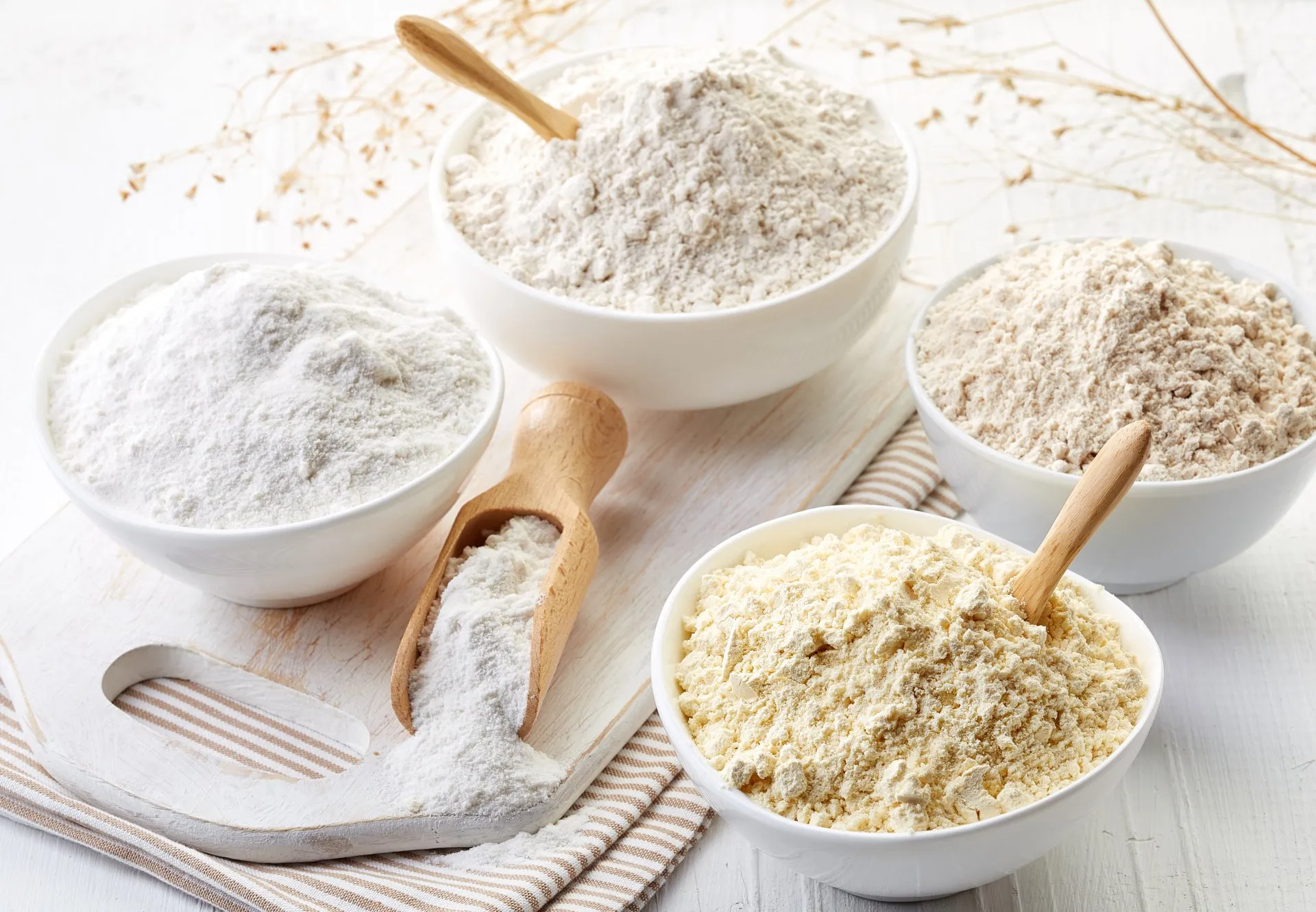Introduction to Gluten-Free Flours
Gluten-free flours are derived from grains, seeds, or other plant sources that do not contain gluten, unlike traditional wheat flour. They provide alternatives for those who avoid gluten due to health reasons or dietary choices. Each flour has a unique nutritional profile, flavor, and baking characteristic, making them suitable for various culinary applications.
The 14 Best Gluten-Free Flours
Almond Flour
Made from finely ground almonds, almond flour is rich in protein, healthy fats, and vitamin E. It’s excellent for making moist baked goods and can be used to thicken sauces or coat proteins.
Coconut Flour
Derived from dried coconut meat, coconut flour is high in fiber, protein, and healthy fats. It is highly absorbent, so only a small amount is needed, and it works well in baking recipes when combined with eggs.
Rice Flour
A staple in Asian cooking, rice flour is made from finely milled rice. It is relatively neutral in flavor and is good for thickening soups and sauces or for use in noodles and gluten-free bread.
Buckwbheat Flour
Despite its name, buckwheat is not related to wheat and is completely gluten-free. It has a strong, nutty flavor and is commonly used in pancakes and soba noodles.
Sorghum Flour
Rich in protein, iron, and dietary fiber, sorghum flour has a mild flavor that makes it versatile for bread, cakes, and other baked goods.
Amaranth Flour
Amaranth flour is made from the seeds of the amaranth plant and is rich in protein and lysine, an essential amino acid. It has an earthy, nutty flavor and works well in combination with other flours.
Teff Flour
Originating from Ethiopia, teff flour is high in protein, calcium, and iron. It has a sweet, malty flavor ideal for baking bread and desserts.
Arrowroot Flour
Arrowroot flour is a starchy substance extracted from the roots of the arrowroot plant. It is excellent for thickening sauces and gravies and is easily digestible.
Corn Flour
Made from whole corn kernels, corn flour has a sweet, hearty flavor and is often used in tortillas, cornbread, and other baked goods.
Chickpea Flour
Also known as besan or gram flour, chickpea flour is high in protein and fiber. It has a strong, slightly bean-like flavor and is popular in Indian and Middle Eastern dishes.
Oat Flour
Made from ground whole oats, oat flour is rich in nutrients and has a mild, slightly sweet flavor. Ensure it’s labeled gluten-free as oats can be contaminated with wheat during processing.
Quinoa Flour
Quinoa flour is made from ground quinoa seeds and is known for its high protein content and earthy flavor. It’s great for adding to bread and muffin recipes.
Tapioca Flour
Derived from the cassava root, tapioca flour is a light, smooth flour that is useful for creating a chewy texture in baking and is commonly used in gluten-free bread.
Potato Flour
Made from whole dried potatoes, potato flour is highly absorbent and adds moisture to baked goods, helping them stay fresh longer.
Tips for Baking with Gluten-Free Flours
Mix Flours
Combining different gluten-free flours can help mimic the texture and taste of gluten-containing flours.
Hydration
Gluten-free flours often require more liquid or binding agents (like xanthan gum) to achieve the right consistency.
Experiment
Gluten-free baking often requires experimentation to find the right blend and proportions for your specific recipe.
Gluten-Free Flour Blends
Creating a homemade gluten-free flour blend can be economical and tailored to specific dietary needs. A common blend includes rice flour, tapioca starch, and potato starch, adjusted for desired texture and flavor.
Health Considerations
While gluten-free flours provide alternatives for those with gluten-related disorders, they vary widely in nutritional content. Some, like coconut and almond flour, are nutrient-dense, while others like rice and tapioca flour are more refined and lower in fiber and protein.
FAQs
Can I substitute gluten-free flour directly for wheat flour?
No, because gluten contributes to the structure and texture of baked goods, recipes need to be adjusted for the lack of gluten when using gluten-free flours.
What is the best gluten-free flour for baking bread?
A blend of gluten-free flours like sorghum, teff, and rice flour combined with a starch like tapioca or potato usually yields the best results.
Are all oats gluten-free?
Naturally, oats are gluten-free, but they can be contaminated with gluten during processing unless specified as gluten-free.
What’s the difference between almond meal and almond flour?
Almond meal is generally coarser and may contain skins, while almond flour is finely ground and typically made from blanched, skinless almonds.
How should gluten-free flours be stored?
Most should be stored in airtight containers in a cool, dry place. Some, like almond and coconut flour, can be refrigerated or frozen to extend their freshness.
Can gluten-free flours be used for thickening sauces?
Yes, flours like arrowroot, cornstarch, and tapioca flour are excellent for thickening sauces and gravies.
Is there a nut-free gluten-free flour option for those with allergies?
Yes, flours like oat, sorghum, and teff are nut-free and provide good alternatives for those with nut allergies.
Conclusion
Gluten-free flours offer diverse options for those avoiding gluten, each with unique nutritional benefits and culinary uses. By understanding the properties and best uses of each flour, anyone can enjoy a variety of delicious, gluten-free dishes.
- Top 12 Foods That Are High in Phosphorus - April 23, 2024
- Almond Butter vs. Peanut Butter: What Healthiest? - April 23, 2024
- The 14 Best Gluten-Free Flours - April 23, 2024


